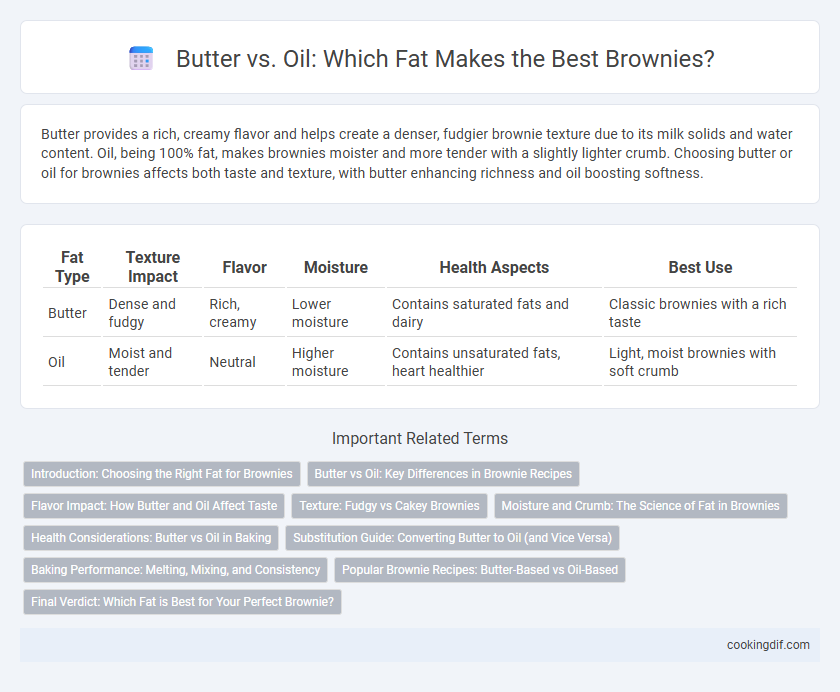Butter provides a rich, creamy flavor and helps create a denser, fudgier brownie texture due to its milk solids and water content. Oil, being 100% fat, makes brownies moister and more tender with a slightly lighter crumb. Choosing butter or oil for brownies affects both taste and texture, with butter enhancing richness and oil boosting softness.
Table of Comparison
| Fat Type | Texture Impact | Flavor | Moisture | Health Aspects | Best Use |
|---|---|---|---|---|---|
| Butter | Dense and fudgy | Rich, creamy | Lower moisture | Contains saturated fats and dairy | Classic brownies with a rich taste |
| Oil | Moist and tender | Neutral | Higher moisture | Contains unsaturated fats, heart healthier | Light, moist brownies with soft crumb |
Introduction: Choosing the Right Fat for Brownies
Butter provides rich flavor and a denser texture in brownies, making them moist and fudgy, while oil yields a lighter, moister crumb with a slightly more tender bite. The type of fat impacts the overall taste, mouthfeel, and shelf life, with butter offering a caramelized depth from browning. For a balance of flavor and texture, many bakers prefer butter, but oil can enhance softness and flexibility in the brownie structure.
Butter vs Oil: Key Differences in Brownie Recipes
Butter in brownie recipes adds a rich, creamy flavor and creates a denser, fudgier texture due to its milk solids and water content. Oil produces moister, more tender brownies with a lighter crumb because it coats flour proteins more effectively, preventing gluten formation. Choosing between butter and oil impacts both taste and texture, with butter offering a buttery depth and oil ensuring a softer, more delicate bite.
Flavor Impact: How Butter and Oil Affect Taste
Butter imparts a rich, creamy flavor that enhances the classic taste of brownies with its natural caramel and nutty notes. Oil produces a more neutral, moist texture, allowing other ingredients like cocoa and sugar to shine without adding distinct flavor. Choosing butter intensifies the overall flavor profile, while oil keeps the taste lighter and more balanced.
Texture: Fudgy vs Cakey Brownies
Butter in brownies creates a rich, fudgy texture due to its solid fat content and ability to promote a dense crumb, while oil produces cakey brownies by contributing to a lighter, more tender crumb. Butter's water content aids in steam production, which slightly lifts the batter but maintains moisture for chewiness. Oil, being 100% fat, coats flour proteins more thoroughly, reducing gluten formation and resulting in a softer, cake-like bite.
Moisture and Crumb: The Science of Fat in Brownies
Butter in brownies contributes to a richer flavor and a denser, fudgier crumb due to its water content, which adds moisture through steam during baking. Oil, being 100% fat, produces a moister, more tender texture with a lighter crumb by coating flour proteins more effectively and preventing gluten formation. Choosing between butter and oil alters the brownie's moisture retention and crumb structure, impacting overall texture and mouthfeel.
Health Considerations: Butter vs Oil in Baking
Butter contains saturated fats and cholesterol, which can raise LDL cholesterol levels and impact heart health, whereas oils like olive or canola provide healthier monounsaturated and polyunsaturated fats that help reduce cardiovascular risk. Oils also contain essential fatty acids and vitamin E, promoting inflammation reduction and skin health, making them a preferable option for health-conscious baking. Choosing oil over butter in brownies can improve the nutritional profile by lowering saturated fat intake while maintaining moisture and texture.
Substitution Guide: Converting Butter to Oil (and Vice Versa)
When substituting butter with oil in brownie recipes, use 80% of the butter's quantity since oil is 100% fat while butter contains about 80% fat and 20% water. Converting oil to butter requires increasing the amount by 25% to account for butter's water content, ensuring a similar fat ratio for proper texture and moisture. This adjustment helps maintain the fudgy, rich consistency characteristic of brownies while adapting to different fat sources.
Baking Performance: Melting, Mixing, and Consistency
Butter provides a rich flavor and creates a tender texture in brownies due to its solid fat content, which melts gradually during baking for even heat distribution. Oil, being liquid at room temperature, blends more uniformly with batter ingredients, promoting a moist and fudgier consistency without the risk of clumping. The choice between butter and oil affects the brownie's melting behavior, mixing ease, and final crumb density, making butter ideal for structurally firmer brownies and oil best for softer, more cohesive results.
Popular Brownie Recipes: Butter-Based vs Oil-Based
Popular brownie recipes often distinguish between butter-based and oil-based fats, each impacting texture and flavor. Butter-based brownies deliver a rich, creamy taste and a denser, fudgier consistency due to the milk solids and water content in butter. Oil-based brownies offer a moister, lighter texture with a tender crumb, making them favored for gluten-free or dairy-free variations.
Final Verdict: Which Fat is Best for Your Perfect Brownie?
Butter provides a richer flavor and a denser, fudgier texture, making it ideal for classic, indulgent brownies. Oil creates a moister, lighter crumb, perfect for a softer and more tender bite, especially in vegan or dairy-free recipes. Choosing between butter and oil depends on whether you prefer intense taste and chewiness or a moist, delicate brownie consistency.
Butter vs Oil for fat choice Infographic

 cookingdif.com
cookingdif.com